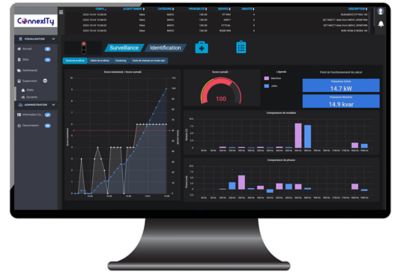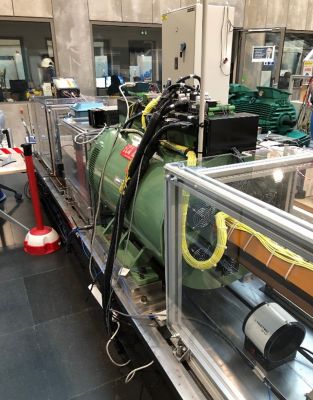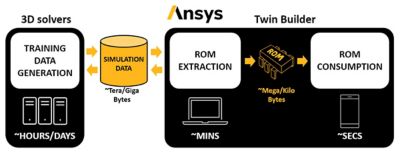-
United States -
United Kingdom -
India -
France -
Deutschland -
Italia -
日本 -
대한민국 -
中国 -
台灣
-
Ansys is committed to setting today's students up for success, by providing free simulation engineering software to students.
-
Ansys is committed to setting today's students up for success, by providing free simulation engineering software to students.
-
Ansys is committed to setting today's students up for success, by providing free simulation engineering software to students.
-
Contact Us -
Careers -
Students and Academic -
For United States and Canada
+1 844.462.6797
ANSYS BLOG
November 4, 2022
Digitally Transforming Nuclear Energy for a More Sustainable Future with the ConnexITy Consortium
Nuclear energy is one of the most sustainable and cleanest forms of energy in the world, with natural origins from the nucleus, or core, of an atom. To create nuclear energy, atoms are split in a thermal reactor, which creates heat that converts water into steam. This high-pressure steam is used to power a turbine linked to a generator and produce electricity. What’s more, nuclear electricity production results in near zero carbon dioxide (CO2) emissions.
Energy production and consumption are the foundation of many of the current sustainable development goals (SDG) set up by the United Nations. One of these goals, commonly known as SDG 7 or Global Goal 7, aims to ensure access to affordable, reliable, sustainable, and modern energy for all by the end of the next decade.
According to the Nuclear Energy Agency (NEA), the analysis of nuclear energy characteristics within a sustainable development framework shows that the approach adopted by the nuclear energy sector is generally consistent with fundamental SDGs while minimizing environmental impacts. Still, to maintain this consistency and meet rising environmental and safety demands, digital transformation within the nuclear energy industry is a necessity.
The ConnexITy consortium, led by the French multinational utility company Électricité de France (EDF), is leading the charge on this initiative. The partnership of 14 companies from the nuclear industry, including Ansys, has a shared goal to create new uses and services based on digital technologies to support the digital transformation of the nuclear industry.
For example, to optimize the maintenance and operation of nuclear power plant sites, the consortium posits: What if nuclear power plants had a solution to predict equipment behavior during operation in real time?
To explore this area and make it a reality, partners EDF, Atos, Assystem, Siemens Energy, Technicatome, Naval Group, and Ansys are developing a workflow using digital twin technology.
A Twin for a Win: Digital Power Plant Solutions
The 2020 NEA report “Unlocking Reductions in the Construction Costs of Nuclear: A Practical Guide for Stakeholders” identifies various technological, organizational, regulatory, and policy key points to accelerate the development of nuclear projects.

Figure 1. Illustration of the ConnexITy digital twin user experience.
Digital transformation is one of three technology approaches highlighted by the report that can be implemented to improve reactor projects and deliver rapid cost reductions in the short term. The digitalization of systems can provide improved engineering methodologies and supply chain integration, enable online monitoring of components, and increase productivity. These advancements can make nuclear plants more cost effective to build and operate, thus facilitating their adoption at a larger scale.
The ConnexITy consortium offers a new and improved solution: a digital twin of a nuclear power plant component. Currently, the consortium is focusing on the turbo generator, which converts mechanical power into electrical at the end of the power generation chain. Due to its important role in the workflow, it is highly beneficial to monitor the turbo generator’s behavior during operation to detect anomalies, avoid unscheduled shutdowns, provide insights so the operator can optimize preventive maintenance, and ultimately reduce related costs. Additionally, by monitoring machine behavior, power plant operators can conserve energy and reduce the carbon footprint of many manufacturing processes.
For these reasons, ConnexITy is using Ansys Twin Builder to design a digital twin of the turbo generator that optimizes maintenance and operation in four steps:
- Monitor: Detect drift with respect to normal asset behavior.
- Identify: Predict root cause of the drift.
- Confirm: Verify that the predicted failure mode reflects the actual normal asset behavior.
- Advice: Provide maintenance guidelines and insight.
According to the Digital Twin Consortium, a digital twin is a virtual representation of real-world entities and processes, synchronized at a specified frequency and fidelity.
Twin Builder enables teams to build, validate, and deploy digital twins, potentially cutting the time required to create accurate product models in half. This encourages optimized life cycle management and true predictive maintenance, saving costs to help maintain a competitive advantage.
A turbo generator is an electric machine that converts the mechanical power generated by a turbine. In this example, drift represents the difference between two quantities. When looking at the quantity of voltage output for a flux sensor, the drift is the difference between the digital twin model prediction and the measurement of the actual quantity.

Figure 2. ConnexITy’s turbo generator test bench, located at the ConnexLab on the Saclay plateau in Paris, France.
The turbo generator’s digital twin can predict the health state of the generator in real time by learning from sensor data and reduced order models (ROMs) of transient electromagnetic behavior. It also uses embedded defect classifiers based on support vector machines (SVMs) to predict probable failure modes. In machine learning (ML), SVMs are supervised models with algorithms that analyze and classify data. In addition, the twin is integrated into Atos’ Codex Smart Edge — an industrial internet of things (IIoT) platform — with a web dashboard that allows visualization and interaction between operators and experts.
While the current focus has been on the generator, the same digital twin technology and approach can be applied to other equipment within a power plant. This wider adoption of digital transformation and the resulting progress toward more sustainability is the driving mission of the consortium.

Figure 3. This diagram illustrates how reduced order models (ROMs) are using machine learning to extract physics from 3D solvers and plug it into the digital twin backend and give access to accurate physical predictions in real time.
The ConnexITy Connection
ConnexITy has been developing research and development programs to integrate innovations in the design and operation of nuclear power plant sites since 2017.
Over the past five years, the consortium has designed, integrated, and evaluated such innovations in a laboratory called ConnexLab, located on the Saclay plateau in Paris, France.
Several of the consortium’s projects are already industrialized, demonstrating the nuclear energy industry’s ability to embrace and implement new technologies into existing workflows.
As such, ConnexITy continues to create new uses and services based on digital technologies to support even greater adoption of digital transformation in the nuclear industry and increase sustainability.
To learn more about the ConnexITy consortium register for Ansys’ on-demand webinar: ConnexITy: Digital Twin of a Nuclear Plant Component.
To explore Twin Builder, request a free trial.











